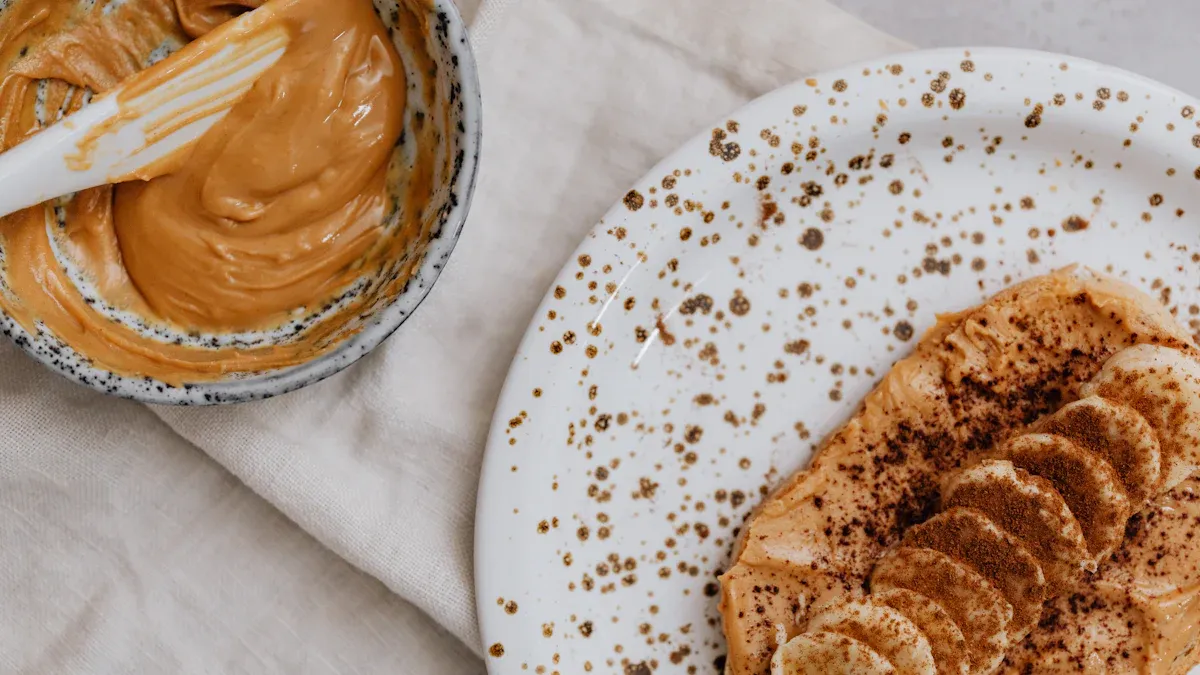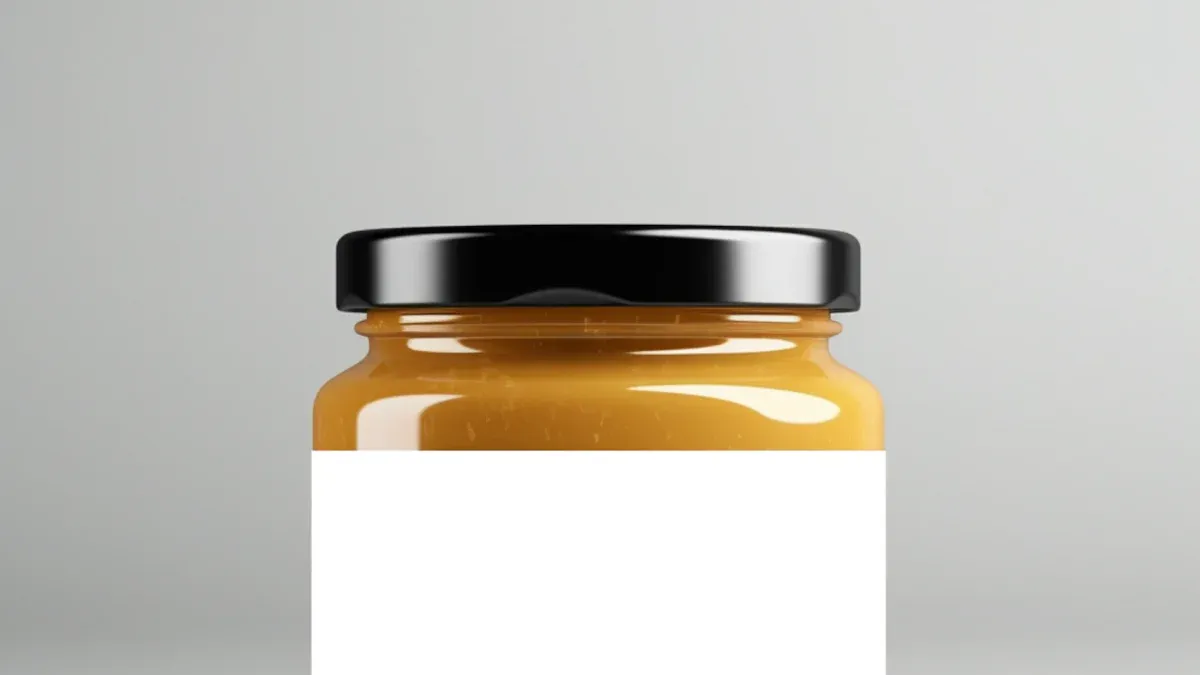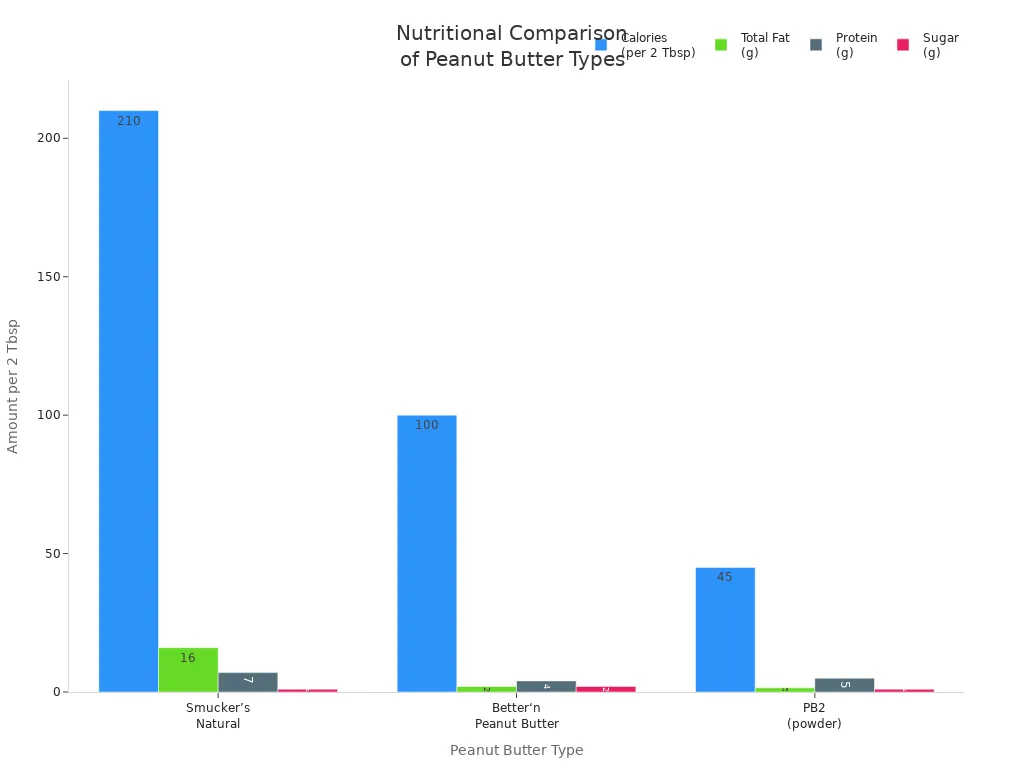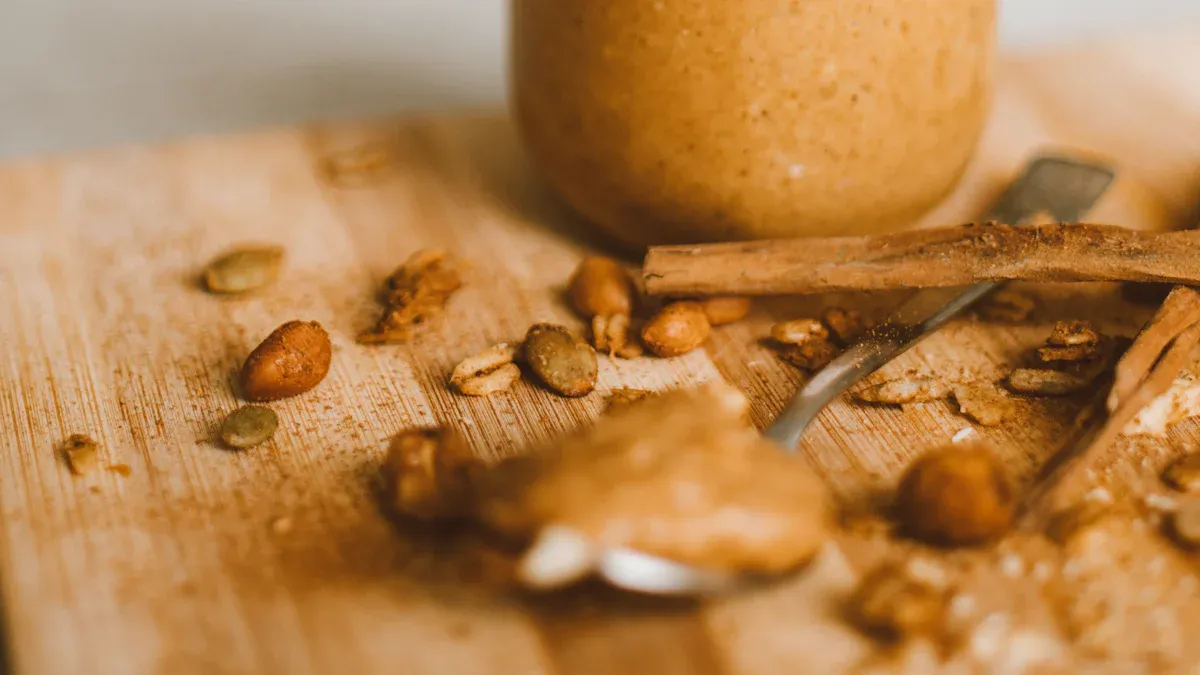Views: 0 Author: Site Editor Publish Time: 2025-07-14 Origin: Site





Many people get confused by peanut butter labels. You might see "organic," "natural," or "regular" and not know the difference. Organic peanut butter uses peanuts grown without fake chemicals. This means you avoid extra pesticides and help the environment. Natural peanut butter has only peanuts and sometimes salt. It has fewer extra things and more protein. Regular peanut butter has sugar, palm oil, and preservatives added. This makes it less healthy. These choices change your health and what you eat.
Organic peanut butter uses peanuts grown without chemicals. It follows strict USDA rules. This makes it healthier and better for the environment.
Natural peanut butter usually has just peanuts and salt. It does not have added oils or sugars. It gives a pure and simple taste.
Regular peanut butter often has added sugar, oils, and preservatives. These things can make it less healthy.
Reading labels helps you pick peanut butter with fewer additives. It helps you find better ingredients for your health.
Picking organic or natural peanut butter is good for you and the planet. Regular peanut butter costs less and tastes sweeter.
If you see "organic" on peanut butter, it follows special rules. The United States Department of Agriculture, or USDA, makes these rules. To call peanut butter organic, a company must do a few things:
Fill out an application and pay money to a USDA-approved group.
Write an Organic System Plan that shows how they grow and make peanuts.
Let the certifying group visit and check their farm or factory.
Use peanuts grown without fake pesticides, weed killers, or chemical plant food.
Stay away from GMOs, strong radiation, and sewage waste.
Peanut butter can have the USDA organic seal if it is all organic or has less than 5% non-organic stuff. If it has at least 70% organic things, it can say “Made With Organic” but cannot use the seal. The certifying group must check and say yes to all labels. Some small farms do not need to get certified if they sell less than $5,000 of organic food each year, but they cannot use the USDA seal or say “organic” on the main label.
Organic farming is different from regular farming. Here is a table to show how they are not the same:
Aspect | Organic Farming Practices | Conventional Farming Practices |
|---|---|---|
Use of Chemicals | No synthetic pesticides or fertilizers | Uses chemical fertilizers and pesticides |
Nitrogen Source | Relies on natural nitrogen fixation | Uses synthetic nitrogen fertilizers |
Soil Microbial Diversity | Higher and more diverse | Lower and less diverse |
Environmental Impact | Reduces pollution, supports soil health | Can cause pollution, may harm soil health |
Crop Yield | Usually lower, but depends on peanut type | Usually higher |
Organic peanut butter has only organic peanuts and sometimes salt. It does not have fake flavors, preservatives, or GMOs. When you pick organic, you help nature and avoid extra chemicals.
Natural peanut butter is a simple kind. It has just peanuts and sometimes salt. Most brands do not add oils, sugar, or preservatives. The list of things inside is often short:
Peanuts
Salt (optional)
You might see oil floating on top in the jar. This happens because there are no added things to keep it mixed. You have to stir the peanut butter before you eat it. Some brands might add a little oil or molasses for color or taste, but this does not happen much.
The word "natural" is not a rule from the government. Companies use it to help sell their product. You should always look at the list of ingredients. Even though natural peanut butter is plain, it does not mean it is organic or non-GMO. It is close to what you could make at home, but you should check the label to be sure.
Regular peanut butter is the kind you see most in stores. It has at least 90% peanuts, but companies add other things to make it taste better and last longer. These things are often:
Salt
Sweeteners like cane sugar or molasses
Fully hydrogenated oils to stop oil from floating
Emulsifiers like lecithin
These extra things make regular peanut butter smooth and easy to spread. You do not have to stir it because the oil does not float. But, added sugar and hydrogenated oils can make health problems like heart disease and diabetes worse. Some brands have kinds with only peanuts and salt, but most regular peanut butter has more things added.
Here is a quick table to compare what is inside:
Peanut Butter Type | Common Ingredients | Notes |
|---|---|---|
Natural | Peanuts, Salt | No added oils or sweeteners |
Organic | Organic Peanuts, Sometimes Salt | No synthetic chemicals, GMOs, or artificial flavors |
Regular | Peanuts, Salt, Hydrogenated Oils, Sweeteners | May contain emulsifiers and preservatives |
Tip: Always check the label. If you want the plainest peanut butter, pick jars with just peanuts and salt.

If you pick organic peanut butter, it is made with only organic peanuts. Some brands add sea salt or organic palm oil. All ingredients must follow strict organic rules. These rules do not let companies use fake pesticides or chemical fertilizers. They also do not allow GMOs. You will not find fake flavors, colors, or preservatives. Many brands use dark-roasted, stone-ground peanuts for a creamy feel. This peanut butter is often vegan, gluten-free, and non-GMO. Using pure ingredients gives it a cleaner, more natural taste.
Main things in organic peanut butter:
Organic peanuts
Sea salt (sometimes)
Organic palm oil or organic cane sugar (sometimes)
Note: Organic peanut butter helps the planet and supports better farming.
Natural peanut butter is very simple. Most jars have just peanuts and a little salt. Some brands add peanut oil or a bit of honey. Most do not use sweeteners or stabilizers. This makes the peanut flavor strong and the smell natural. No preservatives means oil floats on top. You need to stir it before you use it. Fewer extras mean it does not last as long, but many people like the pure taste.
Here is a quick look at what is in natural peanut butter:
Brand Example | Ingredients | Notes |
|---|---|---|
Crazy Richard's | Peanuts | No extra oils or sugar |
Justin's | Dry roasted peanuts, palm oil | No sugar, a little gritty |
MaraNatha | Peanuts, salt, peanut oil | Has an organic kind too |
Tip: Always read the label. Some "natural" brands still add sugar or oil, so check before you buy.
Regular peanut butter has more than just peanuts and salt. Companies add things to make it smooth and last longer. They use hydrogenated oils to stop oil from floating. These oils add more fat and can be bad for your heart. Added sugars like cane sugar or molasses make it sweeter and add calories. Emulsifiers help keep everything mixed together. Some brands use preservatives and fake flavors to make it last longer and taste better.
Common extras in regular peanut butter are:
Hydrogenated oils (soybean, cottonseed, palm, or rapeseed)
Added sugars (sugar, molasses, honey, agave syrup)
Salt
Emulsifiers (mono- and diglycerides)
Preservatives and fake flavors (sometimes)
Picking peanut butter with fewer extras can help you avoid too much sugar and unhealthy fats.
You might want to know how these peanut butters are different. Organic peanut butter uses only organic peanuts. It has fewer calories and no extra sugar or oil. This gives you healthy fats and better protein. Natural peanut butter sometimes has sugar or palm oil. This adds more fat and sugar. Regular peanut butter usually has even more sugar and bad fats. This is because of the extra things added.
Here is a quick chart to show the differences:
Peanut Butter Type | Calories (per 2 Tbsp) | Total Fat (g) | Protein (g) | Sugar (g) |
|---|---|---|---|---|
Smucker’s Natural Peanut Butter | ~210 | 16 | 7 | 1 |
Better‘n Peanut Butter (low-fat alternative) | ~100 | 2 | 4 | 2 |
PB2 (peanut powder) | ~45 | 1.5 | 5 | 1 |
You can also see the differences in this chart:

Organic peanut butter has more vitamins and minerals. These include potassium, magnesium, zinc, phosphorus, and B vitamins. It also has more polyphenols and healthy fats like Omega 3s. You get more fiber from organic peanut butter than regular kinds.
Picking organic or natural peanut butter is good for you:
You get more vitamins and minerals for your body.
Polyphenols in organic peanut butter help keep you healthy.
Omega 3s are good for your brain, heart, and mood.
More fiber and protein help you feel full and control your weight.
Organic peanut butter does not have fake pesticides, weed killers, or GMOs, so you get fewer bad chemicals.
Eating these types may help your blood sugar and cholesterol, help your heart, and lower your chance of some cancers.
Organic farming is better for the earth, which is good for your health too.
Tip: Pick peanut butter with the fewest ingredients for the healthiest option.
There are some things to watch out for with peanut butter. Both organic and regular kinds can have aflatoxins. These are toxins made by mold. Some people think organic peanut butter has more aflatoxins because it uses fewer chemicals. But tests show this is not true. Some organic brands even have less aflatoxin than regular ones. Storing and making peanut butter the right way keeps aflatoxin low in all types.
Peanut butter is a common food allergy. If you are allergic to peanuts, you must not eat any kind. Always check the label for extra things if you have other allergies.
Note: Store peanut butter safely and buy trusted brands to lower risks from toxins.

You can taste clear differences between organic, natural, and regular peanut butter. Each kind has its own flavor.
Natural peanut butter, like Smucker’s Natural Creamy, tastes strongly like peanuts. It is nutty and sometimes a little oily. Some brands taste plain if there is no salt.
Organic peanut butter tastes very pure and nutty. Brands like Justin’s can taste “too natural” for some people. If there is no salt, the flavor can be mild or earthy.
Regular peanut butter, like Jif or Skippy, is sweeter and saltier. Many people like its creamy feel and balanced taste. In taste tests, regular brands often win because they are sweet and smooth.
Tip: If you like sweet and creamy peanut butter, you might like regular peanut butter best. If you want a strong roasted peanut taste, try natural or organic peanut butter.
Texture and consistency are different for each peanut butter type.
Natural and organic peanut butters often have oil on top. You need to stir them before using. They feel thick and sometimes a bit gritty. The texture changes with how much the peanuts are roasted and ground.
Regular peanut butter is smooth and easy to spread. Companies add hydrogenated oils and emulsifiers to keep it creamy. This stops the oil from floating and makes it firmer.
Some “no-stir” natural or organic peanut butters use stabilizers to keep oil mixed in, but most do not use these extras.
Type | Texture | Spreadability | Oil Separation |
|---|---|---|---|
Organic | Thick, gritty | Medium | Yes |
Natural | Chunky or oily | Medium | Yes |
Regular | Creamy, smooth | High | No |
You can use each peanut butter type in different ways:
Stir natural or organic peanut butter well before you spread it. Store the jar upside down to help mix the oil.
Use regular peanut butter for sandwiches, baking, or recipes that need smooth peanut butter.
Try natural or organic peanut butter in smoothies, sauces, or as a dip for fruit and veggies. The strong peanut taste works well in these foods.
If you want less sugar and fewer extras, pick natural or organic peanut butter for snacks and cooking.
Note: Always look at the label for added oils or sugars, especially if you want pure peanut butter.
When you pick peanut butter, think about what is most important. Health, taste, price, and your beliefs all matter. If you care about health, organic peanut butter has more good stuff and fewer chemicals. It keeps more vitamins, minerals, and fiber because it is not changed much. Organic farming helps the earth by keeping soil, water, and animals safe. You also help workers and better farms when you buy organic.
Taste matters too. Some people like peanut butter that is smooth. Others want a strong roasted taste. Natural peanut butter tastes pure and nutty. It usually has fewer extras, so the flavor is cleaner. If you want sweet or creamy peanut butter, regular peanut butter may be best for you.
Price is important for many families. Regular peanut butter is cheaper and easy to find. Organic and natural kinds cost more, but some store brands are not too expensive. You can save money by buying bigger jars or waiting for sales.
Here is a table to help you compare:
Criteria | Organic Peanut Butter | Natural Peanut Butter | Regular Peanut Butter |
|---|---|---|---|
Health Benefits | High | Medium | Low |
Ingredient Transparency | Very High | High | Low |
Environmental Impact | Very Low | Low | High |
Price | High | Medium | Low |
Best For | Health, planet | Health, taste | Budget, convenience |
Tip: Before you buy, think about what matters most—health, taste, price, or helping the earth.
Reading peanut butter labels helps you skip things you do not want. Look for jars with just peanuts and maybe salt. Stay away from added sugar, hydrogenated oils, and preservatives. Some jars say "all natural," but this does not always mean it is pure. Companies can still add oils or sweeteners and use that word.
Check for trusted seals. The USDA Organic seal means the peanut butter follows strict rules and has no fake chemicals or GMOs. The A.A. CLEAN LABEL mark shows there are no unwanted extras or extra sugar. These seals help you pick a cleaner peanut butter.
Be careful with tricky claims. For example, "No Cholesterol" sounds healthy, but all peanut butter has no cholesterol because it is made from plants. Always read the ingredient list and nutrition facts. If you see words you do not know, it might not be as healthy as you think.
Here are some quick tips for reading labels:
Pick peanut butter with simple ingredients.
Skip jars with lots of extras.
Look for USDA Organic or CLEAN LABEL seals.
Do not trust front-label claims; check the back for real info.
Note: If you want the purest peanut butter, choose one with the fewest ingredients and trusted seals.
You have learned how organic, natural, and regular peanut butter are different. Organic peanut butter uses special peanuts and does not use chemicals. Natural peanut butter has simple things, mostly just peanuts and salt. Regular peanut butter has sugar, oils, and things to keep it fresh.
Quick Checklist for Choosing:
Want less extra stuff? Pick organic or natural.
Care about nature? Choose organic.
Like sweet and smooth? Pick regular.
Type | Best For |
|---|---|
Organic | Health, planet |
Natural | Pure taste |
Regular | Budget, sweetness |
Both organic and natural peanut butter are good for you. Choose the one that matches what you like and need!
Organic peanut butter is made with peanuts grown without fake chemicals. It must follow strict USDA rules. Natural peanut butter might use regular peanuts. It usually has just peanuts and salt. But it does not promise organic farming.
You should put natural peanut butter in the fridge after opening. This keeps the oils from going bad. Cold storage also helps it last longer. Stir it before you store it for the best texture.
Yes, you can bake with both types. You may need to stir them first. The taste and feel might change your recipe a little. You will get a stronger peanut flavor.
Regular peanut butter often has sugar, oils, and preservatives added. These extras can add more calories and bad fats. Check the label if you want a healthier peanut butter.